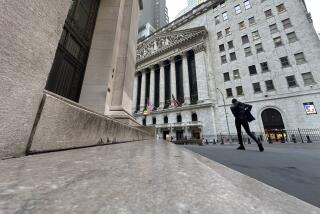Asia woes show little similarity to ’97 crisis
- Share via
SHANGHAI — As stock traders in Asia and elsewhere look for direction in the banged-up markets, they can take heart in at least one thing: This is not 1997.
Back then, when markets from Indonesia to South Korea stumbled, the fall was long and steep, exposing severe weaknesses in corporate finances and in the underlying economies across the region.
Currencies collapsed and stocks crashed, causing a regional financial crisis that brought massive bankruptcies, layoffs and other economic and social ills.
These days Asia again is at the eye of a financial storm. A plunge in Chinese shares last week sparked a global downturn in markets, though they have shown signs of recovering this week. Many analysts believe that Japan also played a key role in the sell-off by raising interest rates that began to squeeze speculators who had bought stocks worldwide with low-cost cash borrowed in Japan.
But the economic foundation in Asia today looks vastly different from a decade ago. Government and corporate debt levels have been pared down substantially. Banks are on more solid footing. Nations’ trade balances are generally positive. Japan’s economy is showing surprising strength. And Asia overall now is a region of creditor nations, not debtors. Governments have mountains of foreign reserves.
“Oh, no. This is nothing close to ‘97,” said Scott Lim, chief investment officer at CMS Dresdner Asset Management in Kuala Lumpur, Malaysia. “I don’t see a meltdown in Asia.”
Like many other professionals, Lim regards the recent slide in share prices as a temporary pullback after sharp gains in many of the region’s markets in recent years.
“This is a watershed sell-off for short-term hedge funds,” he said, but long-term investors remain largely confident, in good part because of the inherent strength of the region’s economy.
Stock markets in Asia mostly opened higher today, building on their rebound of Tuesday and Wednesday. South Korea’s composite stock index, for example, was up 0.7% early today to 1,421.06, after rising 2% on Tuesday and 0.6% on Wednesday.
The South Korean market has recovered about half of its 6.4% drop in the recent sell-off. By contrast, the U.S. Dow Jones industrial average has recouped less than a quarter of its decline.
Other Asian markets also have bounced back but not as strongly as South Korea’s. Malaysia’s main share index still is down about 8.4% from its recent high.
Many analysts warn that volatility in Asian markets could increase in the near term. And one serious risk to the region’s well-being is the possibility of a sharp slowdown in the U.S. economy, which buys a large portion of Asia’s exports.
“I feel something dreadful may be coming,” said Lim Chang-gue, a fund manager at Samsung Investment Trust Management in Seoul. Lim said he was worried that the American economy was vulnerable because of its massive trade deficit.
His other fear: a slowdown in China’s booming economy, a specter raised by the plunge in Shanghai stocks last week.
In Shanghai today, U.S. Treasury Secretary Henry M. Paulson Jr. warned that China’s growth was becoming “increasingly imbalanced” by its dependence on exports. He urged China to open its financial sector to foreign competition, which he said could help the economy become less reliant on its industrial sector.
Despite the risks in the region, Lim said he took comfort knowing that South Korea’s economy, though heavily reliant on the twin pillars of China and the U.S., was in much better shape than in 1997.
In that year, South Korea’s stock market plummeted 42% as its currency, the won, crumbled. The won dived from 880 per dollar in mid-1997 to more than 1,600 per dollar by the end of the year as capital fled the country’s markets. The collapse of purchasing power was a devastating blow.
“We couldn’t do anything but watch. We just asked: Why?” recalled Lim, then a young analyst for a Samsung investment arm.
The nation had to swallow its pride and accept a bailout by the International Monetary Fund.
Since then, the South Korean economy has bounced back strongly as debt levels have plunged. One common measure of companies’ health, the corporate ratio of debt to equity, now stands at less than 100%, down from 400% a decade ago.
The won’s value has rallied back to almost 950 per dollar.
In Thailand, where the 1997 Asian financial crisis began when the Thai baht plummeted, the currency has been rising, rather than weakening, amid the latest global market turmoil. The country’s economy has been growing at a healthy pace, thanks to strong demand for Thai exports. The Thai corporate sector’s debt-to-equity ratio is now less than 60%, and the government’s foreign reserves stand at $67.5 billion, four times the amount a decade ago.
“What’s going on today is totally different in every material way from 1997,” said Eugene Davis, managing director of Finansa, a Bangkok-based merchant banking group.
Donald H. Straszheim, vice chairman of Roth Capital Partners in Newport Beach, agrees with that assessment of Asian economies and their financial health. “They look much more positive ... much less economically risky and scary.”
*
More to Read
Inside the business of entertainment
The Wide Shot brings you news, analysis and insights on everything from streaming wars to production — and what it all means for the future.
You may occasionally receive promotional content from the Los Angeles Times.











